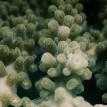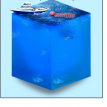Maldives Pole and line Tuna Fishery: Livebait Fishery Review - 2015
17 January 2016
The pole-and-line tuna fishery was accredited by the Marine Stewardship Council as being sustainable in 2012 but with eight conditions, one of which concerned the quantity of livebait being harvested and another with the interaction of endangered, threatened and protected species (ETP) with the livebait fishery. Since 2010, logbook data has been collected throughout the Maldives on the quantity and type of bait being collected by pole-and-line fishers as well as any interactions with ETP species. Initially, low numbers of logbook records were returned and therefore only data from 2011 onwards was included in the analysis.
Logbook returns peaked in 2013 at over ten thousand records but not all of these could be used due to missing pieces of information. Nevertheless, once the data had been filtered for full records, many thousands of data points were used in the analysis. Silver sprat Spratelloides gracilis was the most important bait species throughout the Maldives with varying contributions to livebait catches from blue sprat Spratelloides delicatulus, anchovy Encrasicholina heteroloba, cardinalfish Apogonidae, fusiliers Caesionidae and species of Chromis.
Analysis of catches showed great variability in quantities of livebait between region, year and month. Statistical comparison of catches between years was impaired in many cases by lack of data, but many species showed either no significant difference in catches between years or a decrease from 2011 to 2014, depending on region. Importantly, any differences between years were not consistent by species or region and therefore changes in catches may be related to local depletion or inter-annual variability in abundance of these short-lived species rather than population-level effects of the bait fishery.
Logbook data on interactions of the collection of bait fish with ETP species was lacking and therefore appraisal was made using that collected by independent observers of bait fishing operations. All indications are that ETP species are not harmed in any way by bait fishing and occasional entanglement or entrapment in the gear usually results in the organism in question being released without injury. Sharks and stingrays are an exception (not ETP species globally but do benefit from protection in the Maldivian waters) which occasionally suffer injury when being extracted from the nets used for collecting bait.
Publication can be accessed from the link given below.





